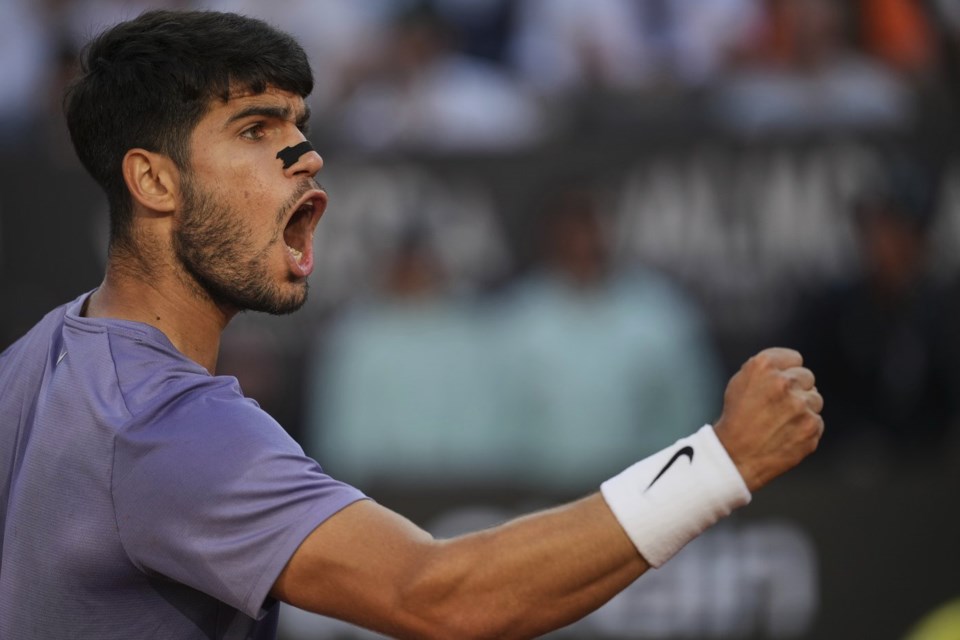PARIS (AP) — If more tennis players find themselves breathing easier, it might just be thanks to .
The four-time Grand Slam champion, whose bid for a second consecutive was scheduled to continue with a third-round match Friday night, has often worn a nasal strip in matches since last season — although not during his first two contests at this week — and the sport's other athletes took note.
After all, if Alcaraz finds something useful on the court, their thinking goes, maybe it makes sense to give the adhesive bands a shot.
“I saw Carlos playing in it,” said 18-year-old , a semifinalist in Paris last year and the No. 6 women's seed this time. “I’d be pretty interested to try and see if there is really a difference. If he plays matches in it, then probably there is.”
At the 2024 season-ending ATP Finals last November, Alcaraz said: “It is something that I’m going to wear more often. I could recover better between points.”
Once associated with Pro Football Hall of Famer Jerry Rice and soccer stars like Cristiano Ronaldo and Neymar, the bands, which essentially look like a Band-Aid worn across the bridge of the nose, are popping up on tennis courts — sometimes out of necessity, sometimes out of curiosity.
They are designed to open the nostrils slightly, making it easier to breathe through the nose. Originally marketed to reduce snoring, they’re being embraced to enhance air intake during physical exertion.
The idea is simple: Better breathing could mean better oxygen intake.
In practice, the science is less convincing.
In 2021, Brazilian academic Ricardo Dinardi reviewed more than 600 studies on nasal strips and found they didn’t make a real difference in how much air athletes took in, their heart rate or how strenuous exercise felt.
“The effect on athletic performance is mostly placebo,” Dinardi said. “But in elite sports, even perceived benefits can count.”
Three-time major finalist , who wore the strips in matches earlier this year, knows the evidence is shaky. But he still liked using them — both on the court and while sleeping. Like Alcaraz, Ruud did not wear one in Paris before his second-round exit.
But he has been testing a prototype of a different version.
“I tried out a device that’s very early in development. It will be a bit more comfortable to wear, because it’s inside the nose and it looks like I have this bullring under,” said Ruud, who was the runner-up at Roland-Garros to Rafael Nadal in 2022 and Novak Djokovic in 2023. “It will return, don’t worry.”
For other players, like Nicolás Jarry, the strips are more than a trend — they’re a necessity. After nasal surgery in 2020, the Chilean still needed help to draw air into his nose, so he puts them on for every practice and every match he plays.
“Without it, I cannot breathe. My nostrils shut when I try,” he said, inhaling to demonstrate for a reporter. “Others don’t have that issue and still use them.”
Jarry definitely has noticed a recent spike in interest among players. He said that even though he's worn the strips for years, including at this French Open, other competitors on tour never asked about them — until Alcaraz started wearing one last year, sometimes in black, sometimes in pink.
“Others have asked me, and many are trying it," said Jarry, who sported a beige-colored strip in Paris. "But before him? Nothing.”
There are those, like , who are tempted to try.
“I have a horrible deviated septum. I can’t really breathe out of one side of my nose," said Pegula, who will play 2023 Wimbledon champion Marketa Vondrousova in the third round Saturday. “Maybe I should start wearing one.”
She admits, though, that the aesthetic aspect might be a deal-breaker.
“I don’t know," Pegula said with a smile, “if I have the confidence to rock one.”
___
AP Tennis Writer Howard Fendrich contributed.
___
AP tennis:
Tom Nouvian, The Associated Press




